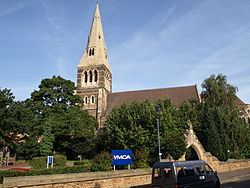- All Saints' Church, Nottingham
-
All Saints' Church Nottingham
Denomination Church of England Churchmanship Broad Church Website http://www.nottinghamchurches.org History Dedication All Saints Architecture Architect(s) Thomas Chambers Hine Style Gothic Revival Groundbreaking 1863 Completed 1864 Construction cost £25,000 Specifications Capacity 800 Spire height 175 feet (53 m) Administration Parish Nottingham Diocese Southwell and Nottingham Province Province of York Clergy Vicar(s) Rev. Christopher Harrison Curate(s) Rev. Chrissie Little All Saints' Church, Nottingham is an Anglican church in Nottingham, England.
The church is Grade II listed by the Department for Culture, Media & Sport as it is a building of special architectural or historic interest.[1]
Contents
Background
It was formerly the Parish Church of All Saints', Nottingham, and then became one of the two churches of the parish of Nottingham, St. Peter & All Saints', on their merger in December 2002. Following a further merger in September 2007, it became one of three parish churches within the parish of All Saints', St. Mary's and St. Peter's, Nottingham. The building itself is a large example of Victorian church architecture.
A map of the parish is available on Google Maps
History
The church was built in 1863–64, mainly in sandstone. Along with the church, a large parsonage and a church school were built at the sole cost (some £10,000) (£740,000 as of 2011),[2] of William Windley JP, a local philanthropist. With all of the ancillary building, the total cost was £25,000 (£1,840,000 as of 2011)[2].
The church was built in Gothic revival style to seat 500, and has a fine broach spire reaching 175 feet (53 m) tall (8th tallest building in Nottingham) and housing a ring of ten bells (the heaviest weighing 16 cwt). The architect was Thomas Chambers Hine, of Nottingham.
The church was consecrated on 3 November 1864. 1200 crammed into the 800 seats and there was a large attendance of clergy.[3] The choir of St. Mary's Church were accompanied by Miss Fanny Brookes on the harmonium. The Rt. Revd. John Jackson, Bishop of Lincoln, performed the consecration service in the presence of the new pastor, Joshua William Brooks.
At the time of its construction, All Saints' Parish was a new wealthy suburb outside the old city boundary of Nottingham on an area previously known as Sandfield. The expansion had been as a result of the 1830s cholera epidemic. With the continued expansion of the City of Nottingham, the parish became an inner-city area of Nottingham which suffered significant decline after the Second World War. By the 1980s it was designated an Urban Priority Area and the congregation declined to around 30–40 at the turn of the millennium.
The old school building, which had fallen out of use in the 1920s, was converted into small workspaces, and half of the original huge vicarage was converted into residences of young single people in the early 1980s. More recently in 2006, following protracted negotiations, the New Deal for Radford bought the old School to refurbish it for use by local organisations.
The church and many of the other buildings are now Grade II listed. It continues to be in use for regular Sunday morning services. Given the small congregation, discussions are underway as to whether there may be other joint uses of the space available.[citation needed]
List of incumbents
-
This list is incomplete; you can help by expanding it.
- Herbert Lovell Clarke 1912–1923
- Paul Watts 1980–1984
- David White 1991-1998
Bells
The six bells were cast by John Taylor & Co of Loughborough on an oak bell frame. At installation in 1864 this was extended to accommodate two extra bells. The bells were tuned in the key of E, the heaviest weighing 17cwt.
In 1999 the bells were tuned and hung in a new steel frame with room for 10 bells. At the same time the redundant All Saints’ School bell was installed as a Sanctus bell. The Nottingham University Society of Change Ringers use the church for practice and also ring the bells for church services.
Organ
The first organ was built by Lloyd and Dudgeon from Nottingham; the current organ is by Norman and Beard and dates from 1906.[4]
List of organists
-
This list is incomplete; you can help by expanding it.
- George Essex ca. 1877[5]
- Frederick William Hughes 1915 - 1918
- F. Wyatt 1918 - ? (formerly of St. Thomas' Church, Nottingham)
- Peter Moule
- Nowadays, there is no regular organist; a team of organists are shared between St Peter's and All Saints, headed by the Director of Music, Peter Siepmann.
See also
- Nottingham University Society of Change Ringers
- St. Mary's Church, Nottingham
- St. Peter's Church, Nottingham
References
- ^ Details from listed building database (458516) - Grade II. Images of England. English Heritage.
- ^ a b UK CPI inflation numbers based on data available from Lawrence H. Officer (2010) "What Were the UK Earnings and Prices Then?" MeasuringWorth.
- ^ Nottingham Journal. 4 November 1864
- ^ "Nottinghamshire, Nottingham: All Saints". National Pipe Organ Register. http://www.npor.org.uk/cgi-bin/Rsearch.cgi?Fn=Rsearch&rec_index=N13534. Retrieved 9 March 2010.
- ^ 1877 Nottingham and District Morris and CO Directory
External links
Categories:- Churches in Nottingham
- 1860s architecture
- Church of England churches in Nottinghamshire
- Grade II listed buildings in Nottinghamshire
- Grade II listed churches
-
Wikimedia Foundation. 2010.

